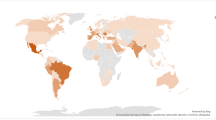Abstract
The objective of this book has been to stress how important it is to prevent postoperative complications by a proper indication for engaging surgery and having a good operative technique. Especially the indication for surgery must be discussed multidisciplinary; it is no longer acceptable that such a determination would only be the work of a solitary surgeon. Having a good surgical technique may imply a lot of things, such as proper standard training based on evidence-based surgery; using techniques demonstratively better than others; and having knowledge of the type of anastomosis and dissection as, for instance, when to mobilize or not the splenic flexure in rectum cancer surgery.
Access provided by Autonomous University of Puebla. Download chapter PDF
Similar content being viewed by others
Keywords
- Prevention of complications
- Evidence base medicine
- Postoperative complications
- Operative technique
- Training
- Developments
- Surgery
The objective of this book has been to stress how important it is to prevent postoperative complications by a proper indication for engaging surgery and having a good operative technique. Especially the indication for surgery must be discussed multidisciplinary; it is no longer acceptable that such a determination would only be the work of a solitary surgeon. Having a good surgical technique may imply a lot of things, such as proper standard training based on evidence-based surgery; using techniques demonstratively better than others; and having knowledge of the type of anastomosis and dissection as, for instance, when to mobilize or not the splenic flexure in rectum cancer surgery.
More evidence on preventing postoperative complications will be required to accomplish these objectives, thereby stimulating an optimal training and continuous and permanent learning to adopt new developments. We note that the introduction of laparoscopic surgery and currently the fast track have changed many aspects of daily practice, reducing hospital stay and complication rates. And thereby not forgetting that surgical times are becoming more complicated with the introduction of neoadjuvant protocols, for each patient is unique, and individualization of surgery has become a reality.
All authors and contributors to this book have succeeded to address these points, thereby stimulating us to go further. It also prompts some considerations I would like to share.
Complications are inherent in surgical work! We have the audacity to treat a surgical disease by means of the knife! Surgical treatment as such means trauma, as it will create an inflammatory response—local as well as general—and an immune response. Patients undergo in surgery profound physiological alterations. The issue now becomes: How to define surgical complications in this context? We can define a complication as an alteration of a smooth and prompt recovery of the patient after an operation. Examples are a wound infection or venous thrombosis but also a urinary infection. Observing and documenting carefully, we realize that almost all patients will have some sort of complication, mostly minor, but also major. Dr. Dindo has defined the principles of an optimal classification for gastrointestinal complications. For young surgeons and residents, it is very important not only to learn about proper indications for surgery and corresponding operative techniques but certainly also to detect postoperative complications early and to treat these adequately. An essential learning point I want to stress is that detection and treatment of complications are very much multidisciplinary practices, as the different authors appointed out so well in their respective chapters about complications. In modern surgery, the internist, gastroenterologists, and radiologist need to work together to accomplish the objective to detect early and to treat adequately the postoperative complications occurring. Early detection means proper and careful clinical observation. If the patient is doing well and recovers quickly, then he/she can go home, but when certain factors appear, such as abdominal pain and fever, because a patient does not progress properly or even is getting sick, laboratory studies and eventually CT-scan diagnosis must become a standard performance. Doing this promptly relates positively to better outcomes, less complications, and less mortality. All authors have stressed these important basic points in their respective chapters. Lack of progress in being timely means having complications!
A much more difficult topic and more subjective to value is how to treat major complications. At the same time, we recognize an abundance of evidence in this volume on how to treat major complications and when to do so.
All authors have stressed such points and we can be grateful for their candor. A golden standard implied in each chapter is the maxim that in case of a major complication, the surgeon first must save the life, second must save the organ, and third must save the cosmetics. At the same time, it is unavoidable that adequate treatment of the sepsis will imply radical measures. This affirms again that multidisciplinary cooperation is of paramount importance for gaining excellence.
Remarkably, all authors expressed their willingness to engage in permanent learning regarding surgery. In particular, I laud the work of many residents and young surgeons, who by writing clearly about the complicated cases have been able to portray their own performance of professional practice understandably for a broad audience. Finally, we must recognize with distinction the essential role of the anesthesia and intensive care personnel on whom all of us rely day in and day out for performing the challenges of major surgery.
Author information
Authors and Affiliations
Corresponding author
Editor information
Editors and Affiliations
Rights and permissions
Copyright information
© 2014 Springer-Verlag London
About this chapter
Cite this chapter
Cuesta, M.A., Bonjer, H.J. (2014). Final Considerations. In: Cuesta, M., Bonjer, H. (eds) Treatment of Postoperative Complications After Digestive Surgery. Springer, London. https://doi.org/10.1007/978-1-4471-4354-3_26
Download citation
DOI: https://doi.org/10.1007/978-1-4471-4354-3_26
Published:
Publisher Name: Springer, London
Print ISBN: 978-1-4471-4353-6
Online ISBN: 978-1-4471-4354-3
eBook Packages: MedicineMedicine (R0)



